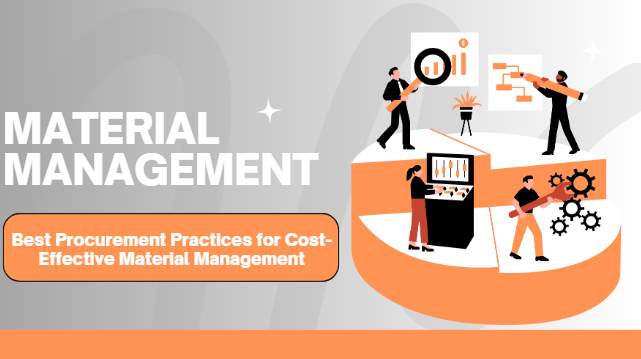
In today’s competitive business market, firms must follow optimal procurement practices to ensure cost-effective material management. In order to maximize supply chain efficiency, cut expenses, and guarantee a smooth material flow, procurement is essential. Companies can improve efficiency, quality, and profitability by using effective procurement practices. In this comprehensive study, we’ll look at key procurement tactics, material management strategies, and effective supply chain optimization.
Understanding Procurement and Material Management
Procurement is the process of getting goods and services from external sources while ensuring that resources are obtained at the appropriate timing, cost, and quality. Material management, on the other hand, is concerned with effectively planning, arranging, and regulating the flow of materials in order to satisfy production demands. Together, they constitute the foundation for effective supply chain optimization.
Procurement Best Practices for Cost-Effective Material Management
1. Develop a Strategic Procurement Plan
Businesses can make sure that their purchasing selections are in line with their objectives by using a well-structured procurement plan. This includes studying demand patterns, creating budgets, and evaluating suppliers.
- Perform market research to comprehend trends in prices.
- Clearly define your procurement goals.
- Create a procurement team to manage activities.
2. Supplier Relationship Management (SRM)
Better pricing, quality control, and on-time delivery are all possible outcomes of developing solid connections with suppliers. Companies should prioritize long-term supplier partnerships over one-time transactions.
- Regularly assess the performance of your suppliers.
- Negotiate better terms for your contracts.
- Continue to collaborate and communicate openly.
3. Effective Vendor Selection Criteria
Choosing the correct vendors is critical to ensure material quality and cost-effectiveness. Businesses should create a vendor selection procedure based on important standards like:
- Certifications and criteria for quality
- Cost and terms of payment
- Delivery timelines
- Customer support and service
4. Implement Cost-Effective Procurement Techniques
Organizations place a high premium on lowering procurement costs without sacrificing quality. Some of the most effective strategies include:
- Purchasing in bulk: Bargaining for lower prices on larger purchases
- Just-in-time (JIT) procurement: Ordering materials just when needed to reduce storage expenses.
- E-auctions: Securing competitive pricing through the use of digital bidding platforms
5. Leverage Technology for Procurement Process Improvement
Automation and digital tools improve the procurement process by decreasing errors and enhancing efficiency. Procurement software can be used by businesses to maintain inventory levels, manage supplier databases, and examine buying patterns.
- To forecast demand, use AI-driven procurement tools.
- Install inventory management systems that are cloud-based.
- Streamline processes with electronic purchase orders.
6. Sustainable Procurement Methods
The relevance of sustainability in procurement is growing as businesses look to minimize their environmental impact while maintaining economic effectiveness.
- Choose eco-friendly materials.
- Work with sustainable merchants who follow environmental rules.
- Reduce waste by optimizing material use and recycling.
Techniques for Material Management to Reduce Costs
1. Inventory Management Tips for Optimal Stock Levels
Effective inventory management helps companies avoid overstocking and stockouts, which can result in financial losses.
- ABC Analysis: Prioritize inventory items by value and consumption.
- Economic Order Quantity (EOQ): Determine the ideal order quantity to save money.
- Inventory Turnover Ratio: Track how often inventory is utilized and replenished.
2. Warehouse Management Strategies for Efficiency
An orderly warehouse lowers storage expenses and increases the effectiveness of material handling.
- Implement automated storage systems, such as RFID tagging.
- Implement a FIFO (First-In, First-Out) system to prevent material waste.
- Regularly check warehouse inventory to identify obsolete items.
3. Supply Chain Optimization for Seamless Operations
By ensuring a steady material flow, an optimized supply chain lowers operating costs and delays. Companies can use the following strategies:
- Establish real-time shipping tracking
- Establish collaborative connections with logistical providers.
- Utilize data analytics to forecast changes in demand.
Benefits of Best Procurement and Material Management Practices
✅ Cost Reduction: Minimizing procurement and storage expenses
✅ Improved Supplier Performance: Ensuring timely deliveries and quality compliance
✅ Better Inventory Control: Preventing stock shortages and excess storage costs
✅ Sustainability: Reducing environmental impact through ethical sourcing
✅ Enhanced Productivity: Streamlining workflows and reducing manual tasks
Advance Your Career with the Best PGDM in Material Management Courses
Professionals seeking to thrive in procurement and material management can improve their skills through specialized courses. With its excellent PGDM in Material Management, MITSDE provides students with the most up-to-date supply chain insights, cost-effective methods, and procurement tactics.


